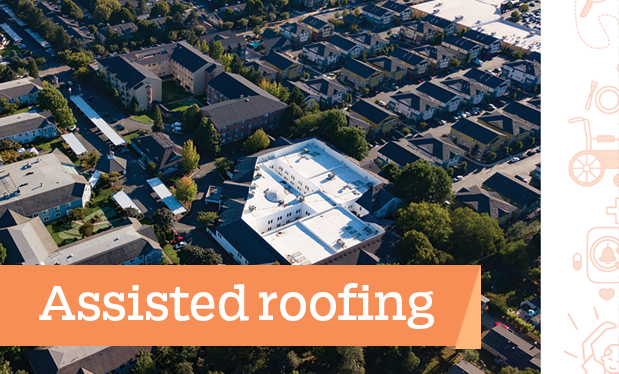NRCA's Technical Services Section has been receiving inquiries regarding the use and effectiveness of specific concrete mix additives and topical surface treatments to address moisture release-related concerns with concrete roof decks. Such admixtures broadly are referred to as moisture vapor reduction admixtures (MVRAs) or porosity-inhibiting admixtures. NRCA provides recommendations regarding their use.
MVRAs
Concrete admixtures intended as MVRAs are specific chemicals added during concrete's batching and mixing to provide an additional chemical reaction during the concrete's hydration and curing process. MVRAs use the concrete mix's excess water and chlorides to create a calcium silicate hydrate gel within the concrete. The gel is said to fill the small pores and capillary openings in curing concrete, minimizing the concrete's ability to pass and release moisture vapor. The gel is intended to be permanent and integral throughout the concrete's entire thickness.
MVRAs are available from several manufacturers and typically are added to a concrete mix at the concrete batch plant separately from the addition of any other admixtures. Some MVRA manufacturers permit their MVRAs to be added to concrete mixers at job sites provided a concrete mixer's drum is rotated for a manufacturer's recommended minimum amount of time after dosage and before concrete discharge and placement. Recommended MVRA dosages typically range from about 10 to 14 ounces per 100 pounds of cementitious materials.
Some MVRA manufacturers claim their admixtures also reduce placed concrete's bleed water, creating a richer surface paste, which can aid in concrete surface finishing.
MVRAs reportedly have been used successfully to address moisture release affecting flooring covering applications over concrete slabs on grade and intermediate floor levels. To attempt to address the roofing industry's concerns with moisture release from concrete roof decks, several MVRA manufacturers are promoting the use of MVRAs in concrete roof decks.
Several manufacturers also are promoting the use of spray-applied, porosity-inhibiting, topical surface treatments intended to function and perform similarly to MVRAs. Such surface treatments are applied after concrete placement and reportedly penetrate concrete to seal the concrete's surface to minimize the passage of moisture vapor. The depth of surface treatment penetration into concrete depends on several factors, including the specific type and amount of surface treatment being used and the concrete's surface porosity at the time of surface treatment application.
Roofing-related considerations
Designers' and general contractors' interest in specifying the use of MVRAs and porosity-inhibiting surface treatments are their acknowledgement and attempt to address moisture release-related concerns with concrete roof decks.
However, though MVRAs and porosity-inhibiting surface treatments may perform successfully in concrete slab on grade and intermediate floor level applications, concrete roof decks experience fundamentally different conditions.
Environmental conditions (temperature and humidity) above and below a building's intermediate floor slabs typically are about the same because these conditions are controlled by the building's HVAC system. As a result, there usually is little to no vapor pressure drive through floor slabs.
Conversely, with concrete roof decks the environmental conditions on the bottom side (interior) of a roof deck differ from those on the top side (exterior), resulting in measurable vapor pressure drive through roof decks. The magnitude and direction of this vapor pressure drive will change with weather conditions.
For MVRAs and porosity-inhibiting surface treatments to perform successfully in concrete roof deck applications, they need to be able to withstand the magnitude and direction of vapor pressure drive a roof assembly will experience during its service life. NRCA is not aware of any data documenting MVRAs' or porosity-inhibiting surface treatments' abilities to withstand these roof assembly conditions. There is anecdotal evidence and field experience to the contrary.
NRCA's recommendations
NRCA continues to have concerns regarding moisture release with newly placed concrete roof decks even when MVRAs or porosity-inhibiting surface treatments are used.
NRCA maintains its recommendation that designers specify a vapor retarder with high bond strength be adhered directly to newly placed concrete roof decks. This also applies to concrete roof decks on which MVRAs or porosity-inhibiting surface treatments are used. Roof system designs using mechanical fasteners penetrating vapor retarders should be avoided.
Additional information about concrete roof decks and moisture-related concerns is contained in Chapter 2-Roof Decks of The NRCA Roofing Manual: Membrane Roof Systems, which is available as a free download for NRCA members at shop.nrca.net.
Also, during the 2019 International Roofing Expo,® which will be held Feb. 11-13 in Nashville, Tenn., NRCA will present the latest findings from its concrete moisture research at the NRCA Technical Operations Committee: Technical Programs and Issues program.
Mark S. Graham is NRCA's vice
president of technical services.
@MarkGrahamNRCA
This column is part of Research + Tech. Click here to read additional stories from this section.



